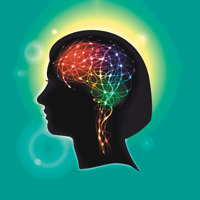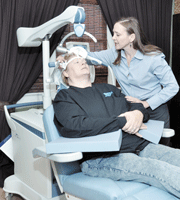Can brain stimulation aid memory and brain health?
Can brain stimulation aid memory and brain health?
 Image: Thinkstock Image: Thinkstock |
The jury is still out, but magnetic fields or mild electric currents may aid learning and help several conditions that affect women in particular.
Stimulating your brain doesn’t just mean spending an evening at the theater or reading a good book. These days it can involve sitting with your head against a magnet or wearing electrodes that transmit a low-voltage current through your scalp to activate—or suppress—certain neurons in your brain. The prospect of regulating brain signals responsible for mood, pain, and learning is so compelling that scores of studies are under way to see if, and how, the approach can be used to sharpen mental skills and treat symptoms of several mind-body disorders. “Brain stimulation, if used carefully and safely, looks promising, especially if combined with other therapies,” says Dr. Daniel Press, a neurologist with the Berenson-Allen Center for Noninvasive Brain Stimulation at Harvard-affiliated Beth Israel Deaconess Medical Center. Dr. Press has used noninvasive brain stimulation for almost a decade.
How do the devices work?
Two types of brain stimulation are available today. Each has FDA clearance for at least one medical purpose but is being used in clinical trials and “off label” to treat several medical conditions.
|
In TMS therapy, the physician positions the magnet to stimulate neurons in a specific area of the brain that is underactive in people with |
Transcranial magnetic stimulation (TMS) uses a magnetic field generated by a coil in a paddle that is held against the patient’s head to stimulate specific areas of the brain. This form of therapy is also called repetitive TMS or rTMS because the magnet is turned on and off rapidly, creating an effect that feels as though someone is tapping on your head. The magnet emits loud noises as it is turned on and off, which requires people undergoing TMS therapy to wear earplugs during the 40-minute sessions. Side effects are usually limited to headaches and ringing in the ears.
Transcranial direct current stimulation (tDCS) transmits a weak current from a 9-volt battery (the size used in a smoke detector) through electrodes on the forehead or scalp. People who undergo tDCS may feel their scalp tingle and hear a humming noise. Each session lasts about 20 minutes.
Both TMS and tDCS are being used to treat the following:
Depression. TMS stimulates neurons in the prefrontal cortex, a region of the brain that is underactive in people with depression. TMS received FDA clearance in 2008 for treating people with depression for whom drugs haven’t been effective. It may also be an alternative for women with depression who are pregnant or breastfeeding and thus may not want to take antidepressants. Unlike electro-convulsive therapy, which is also approved for depression that isn’t alleviated by medication, TMS isn’t likely to cause seizures or memory loss. Insurance may cover TMS therapy.
TDCS, which is FDA-cleared only to speed the absorption of certain medications through the skin, is also being used to treat depression. Because tDCS is still considered experimental, insurance won’t pay for this therapy for depression or any other condition.
Chronic pain. In a recent review of several randomized controlled clinical trials of TMS, Harvard re-searchers concluded that it was effective in treating nerve pain, including back and leg pain, pain and numbness in hands and feet caused by diabetes, and fibromyalgia. Although there are fewer data for tDCS, it may also be effective for those conditions.
Damage from stroke. Preliminary research suggests that TMS and tDCS may improve a person’s ability to move and speak and to overcome what’s called spatial neglect—the inability to notice or recognize objects on one side of the body. (Stroke damage on the right side of the brain affects the visual field on the left.)
Eating disorders. In early studies, both TMS and tDCS have reduced episodes of binge eating and bulimia in women with those eating disorders.
Migraine. A portable device that delivers a different type of TMS has received FDA clearance for treating migraine headache with aura (headache preceded by flashes of light, tingling, or other sensory disturbances). The manufacturer is conducting post-marketing studies at several headache centers before making it available by prescription.
Tinnitus. Researchers are exploring new ways to deliver TMS to reduce or eliminate the perception of ringing in the ears or other sounds within the head.
Memory and learning. In the last few years there have been scores of studies evaluating the effect of TMS or tDCS on people’s ability to perform mental tasks, particularly those that involve discerning visual patterns, re-calling lists of unrelated words, or doing math problems. Over all, the results indicate that the techniques are most likely to improve mental function when used in conjunction with other types of training, such as learning new systems for remembering names. A few small studies in people with mild Alzheimer’s disease suggest that TMS could be combined with cognitive exercises to improve function.
If you’re interested in noninvasive brain stimulation
You can locate the nearest medical facility that offers TMS to treat depression by going to the website of NeuroStar, the TMS system with FDA clearance for treating depression (www.neurostar.com), and entering your ZIP code. The best way to get TMS or tDCS therapy for other medical conditions or to improve cognitive function is to enroll in one of the scores of clinical trials seeking volunteers. To find one in your area, go to the study database maintained by the National Institutes of Health at www.clinicaltrials.gov.
Can brain stimulation aid memory and brain health?的更多相关文章
- L308 New brain cells made throughout life
People keep making new brain cells throughout their lives (well at least until the age of 97), accor ...
- Memory loss【记忆缺失】
Memory Loss Losing your ability to think and remember is pretty scary. We know the risk of dementia ...
- EEG: electrode positions & Broadmann atlas
Source: http://www.brainm.com/software/pubs/dg/BA_10-20_ROI_Talairach/nearesteeg.htm Area LEFT RIG ...
- CET4
Directions: For this part, you are allowed 30 minutes to write a short essay on the challenges of st ...
- 26 Time Management(转)
01. There is alway time. Time is priorities. 时间常有.时间优先. 02. Days always fill up. 时间总会有的. Only plan f ...
- (转)Let’s make a DQN 系列
Let's make a DQN 系列 Let's make a DQN: Theory September 27, 2016DQN This article is part of series Le ...
- ADNI以及study design简介
相关名词: MCI:轻度认知功能障碍 EMCI:早期认知障碍 MCI:轻度认知障碍 LMCI:晚期认知障碍 CN:认知正常的志愿者 DTI:doppler tissue imaging,多普勒组织显像 ...
- 英语每日阅读---8、VOA慢速英语(翻译+字幕+讲解):脸肓症患者记不住别人的脸
英语每日阅读---8.VOA慢速英语(翻译+字幕+讲解):脸肓症患者记不住别人的脸 一.总结 一句话总结: a.neural abnormalities are more widespread:Duc ...
- [C3] Andrew Ng - Neural Networks and Deep Learning
About this Course If you want to break into cutting-edge AI, this course will help you do so. Deep l ...
随机推荐
- js键盘事件全面控制详解【转】
js键盘事件全面控制 主要分四个部分第一部分:浏览器的按键事件第二部分:兼容浏览器第三部分:代码实现和优化第四部分:总结 第一部分:浏览器的按键事件 用js实现键盘记录,要关注浏览器的三种按键事件类型 ...
- ios外包公司—北京动点软件分享:IOS工程自动打包并发布脚本实现
前言 IOS的开发过程中,当需要给测试人员发布测试包的时候,直接使用xcode来做的效率是非常低下的.尤其是当有一点小改动需要重新出包时,那简直是个折磨的人的工作.通过一番研究后,遂决定写一系列脚本, ...
- ios外派—本公司长年提供ios程序员外派业务(北京动点软件,可签合同)
北京动点飞扬长年提供ios工程师外派业务. 我公司程序员平均技术情况如下: 1.二年以上iPhone/ipad开发经验:2.熟练使用Xcode.Objective C编码技能:3.熟悉iOS开发框架, ...
- Python 上传和更新函数模块到PyPI
1. update setup.py from distutils.core import setup setup( name = 'iamericnester', version = '1.4.0' ...
- memcache 永久数据被踢
1.memcache的slab chunk 就像公交车的坐位一样,有大小之分,还有活跃的状态. 2.代码 index.php -->插入数据,注意$value的大小和重复次数,跟chunk和其数 ...
- 求助:为什么我用360浏览器和UC浏览器打不开JAVA中的index.html文件? 一打开就显示浏览器首界页
如下图,在oracle官网下载了一个JAVA的API文档,双击index.html时打开是浏览器的首页,不知道为什么?请问怎样才能以chm文档格式显示?
- 8. redis的主从复制和sentinal
一. redis主从复制(读写分离) redis的主从复制分为两类节点:1个master和多个slave,master进行读写操作,slav进行只读操作 启动步骤: 主节点照常启动,slave节点启动 ...
- Java compiler level does not match the version of the installed Java project facet. springmvc1 和 Target runtime Apache Tomcat v7.0 is not defined.
Java compiler level does not match the version of the installed Java project facet.springmvc1 : Targ ...
- Spark工程开发常用函数与方法(Scala语言)
import org.apache.spark.{SparkContext, SparkConf}import org.apache.spark.sql.{SaveMode, DataFrame}im ...
- PO_PO系列 - 请购单系统分析(案例)
2014-07-01 Created By BaoXinjian

